How to best feed your chickens (it’s time to put down the treats)
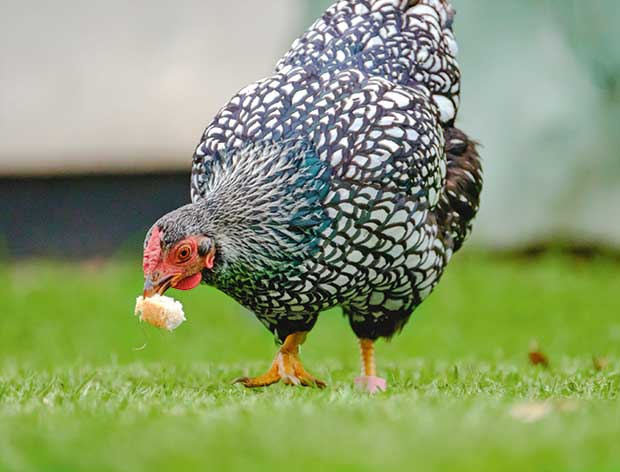
The poultry diet tends to look bland to humans, but adding ‘treats’ to it can work against you.
Words: Sue Clarke
It’s in our nature to spoil our favourite animals. One way a lot of poultry owners do this is by feeding their flock ‘treats’.
“They love them!” is a common comment to see on poultry forums I contribute to. People enjoy seeing their birds run up and greedily gobble down something extra, but it’s not the same reason you might have for scoffing down a slice of cake or a handful of chips.
Poultry do have taste buds, on average 240-360 compared to a human’s 10,000. Only two per cent are on a bird’s tongue, the rest are on the palate (69 per cent),
the cheeks and the floor of the mouth around the salivary glands.
This small number gives poultry the ability to taste ‘bitter’ but very little else. So why do your flock rush to a treat food? There are its energy requirements, but research shows poultry are genetically programmed to be competitive about food as a survival tactic.
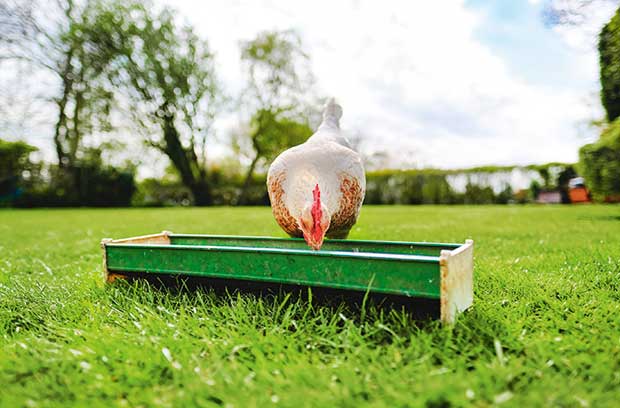
Poultry do have taste buds but only enough to taste ‘bitter’
A study of hens comparing those feeding alone to ones feeding with another bird show they eat faster and will grab more at food when another bird is present.
Another reason is safety. In the wild, poultry risk being seen by a predator when out in the open so it’s a matter of urgency to eat and get back to a secure position.
“You are what you eat” is as true for poultry as it is for us and all other animals. To function at an optimum level, to grow and then stay at a healthy weight, to reproduce and to maintain a robust immune system requires a balanced diet. This is one which provides all the nutrients essential to a bird’s stage of life.
These requirements vary. Chicks need higher protein and low calcium. Adult hens need less protein and far higher levels of calcium.
The nutritional requirements of poultry have been well studied over the past 100 years. Avian nutritionists working for feed manufacturers are constantly looking at ways to optimise feed efficiency and investigate the best options for feeding both layer and meat birds.
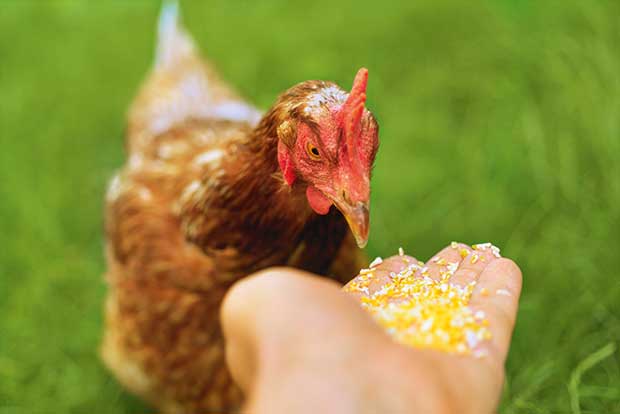
You can easily benefit from all of this knowledge. The easiest thing to do is to choose a good quality, balanced feed designed for your flock’s age. Buy enough to last your flock a few weeks at a time as ingredients like vitamins and fats can become less nutritious as months go by.
Before we could buy feed in convenient bags, the small flock keeper had to make up their own from ingredients that were readily available locally. This meant a flock’s diet would vary throughout the year according to what grains and fruits were available and whether there was access to home-produced meat and milk. The nutritional value of the feed was mixed at best.
Poultry were also nothing like they are now. Intensive breeding programmes have created birds that lay far more eggs, more consistently, and that grow meat rapidly. Poultry management is also different.
Commercial flocks live in temperature, humidity and light-controlled housing, which means seasonal issues like moulting or lower production due to cold can be managed or avoided.
WHAT TO FEED?
This is a common question for those new to poultry and my advice to anyone is to buy the best quality commercial feed you can source locally. This will be worthwhile for a number of reasons:
• the nutrients are consistent all year round as the feed must meet minimum standards according to its specifications for protein, energy and vitamin/mineral levels;
• the higher the energy and protein, the less the birds will need;
• the micro ingredients (vitamins and minerals, which are hard to get right when doing it yourself) will be supplied at the levels required by the birds;
• biotin, selenium and the right balance of calcium to phosphorous and vitamin D will be in the right proportions to be available for a bird to use;
• you can buy specially formulated feed for the age of birds, eg starter with its low calcium for chick, layer with its lower protein and higher calcium for adult hens.
UNDERSTANDING WHAT DRIVES APPETITE
The average layer hen (ie, a Brown Shaver or Hyline) or a light breed like a Leghorn needs about 17g of protein per day and a diet which provides at least 280 kcals of energy.
Heavy breeds tend to eat far more in quantity but can do well on feeds with lower quality protein and energy.
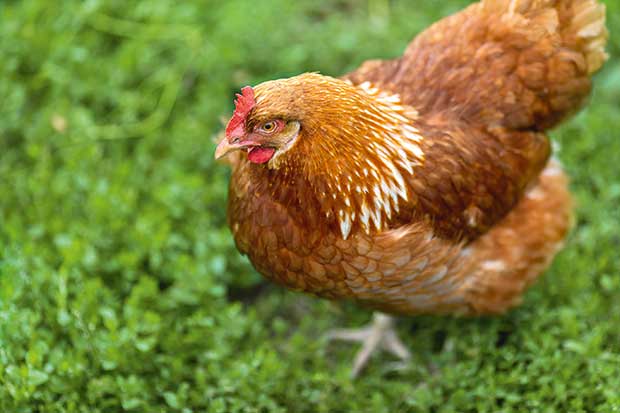
Poultry have an innate drive to eat whatever they can find to reach these daily protein and energy goals thanks to their genes. Hormones tell it to feed, and once it has the nutrients it needs, other hormones are released that tell it to stop eating.
A hen eating 100g per day of commercial layer feed (16 per cent minimum crude protein) will get almost enough to meet her needs. If she eats a little bit more she will get her 17g/day of protein.
If she gets an extra 10g of grain as well, she will also get her daily allowance. However, grains are only 8-13 per cent protein. The more grain you feed to reduce the amount of pellets you feed, the more your hen will need to eat and it still may not be possible for her to physically take it in and process it.
In summer you need to feed a high protein feed as hot weather can decrease appetite.
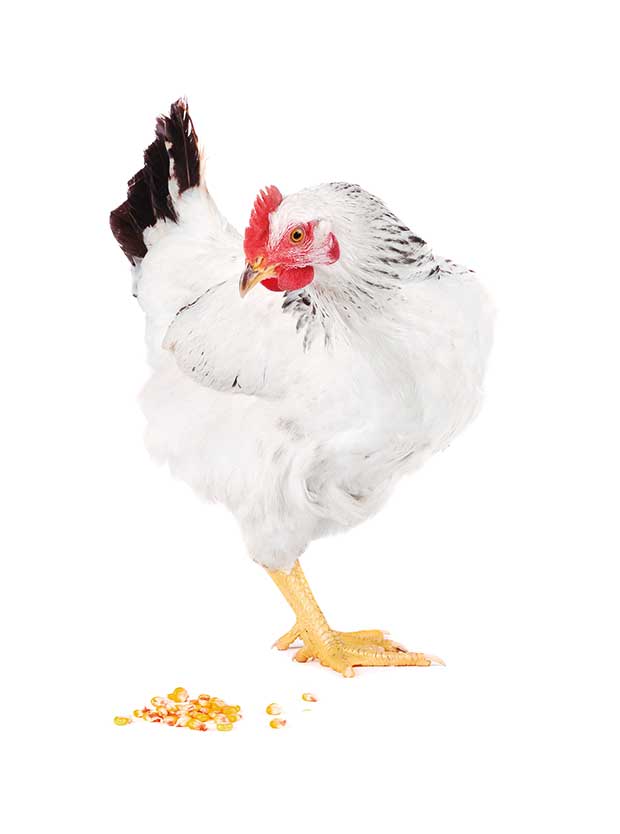
In summer, you need to feed a high protein feed as hot weather can decrease appetite.
When birds are moulting you need to increase the protein level as feathers are 85 per cent protein and it’s a big ask for a bird to do this on a restricted diet, something people often do when their hens aren’t laying. Moulting is a process that helps a hen prepare its body for the coming year of laying.
Restricting her feed at this time will cost you in the laying year to come.
FEEDING EXTRA GRAINS
Ideally, poultry should get access to a balanced, quality feed before scratch grains or food treats.
Scratch grains include wheat, barley and maize (corn) and are the traditional image of feed for chickens. However, grains are very low in essential nutrients and are a poor source of protein.
Barley is poorly digested by poultry. It is used in commercial feeds but they add special enzymes to aid its digestion and absorption. Whole maize is not as useful to a bird as kibbled or cracked maize. These quite large, very hard kernels often pass through the digestive system whole. It is the lowest protein content of all grains but highest in energy terms.
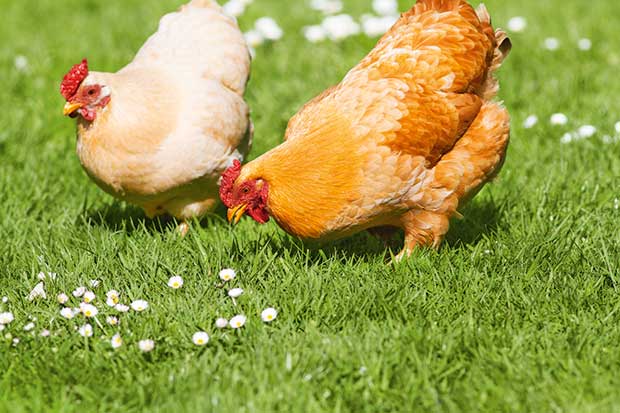
New Zealand-grown grains are also deficient in necessary micro-ingredients like selenium and biotin (due to our soils). These are always added to commercial feeds to avoid deficiencies.
Ideally, scratch grains should be limited to 10g per bird per day. The best way to use them is as an enticement to get your flock home to roost.
Free range birds which are only fed wheat or other grains in addition to what they can forage will often lay at a much lower level than what they are capable of. It can stunt their annual production to less than 100 eggs, when most breeds can lay two to three times that on a quality diet.
Birds fed a diet of 50-50 mix of pellets and scratch grains that aren’t producing well will respond if the ratio of pellets is taken up to near optimum levels (90 per cent) or if they are supplemented with high protein and fat.
WHAT TO DO IF YOU WANT TO FEED KITCHEN SCRAPS
When people ask about feeding out kitchen leftovers, their definition of ‘scraps ’is often vague. It also varies depending on the household.
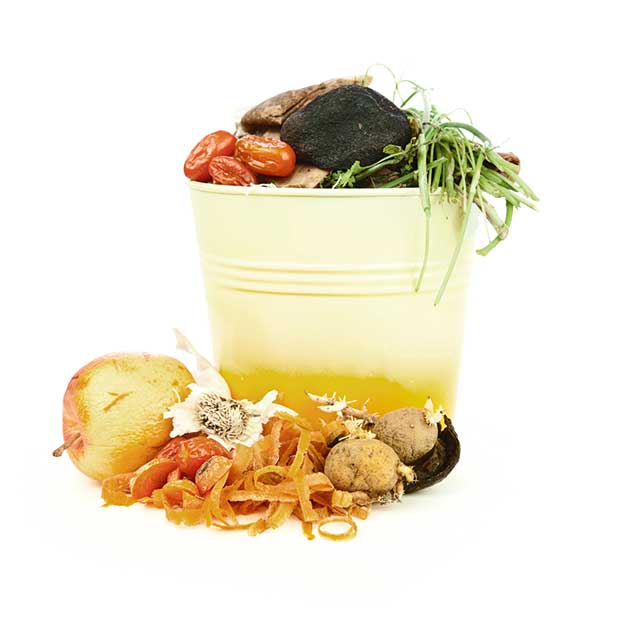
If you want to feed scraps, you need to also ensure your flock is getting the nutrients they need to be healthy and productive.
• Before you feed scraps, offer your flock a balanced commercial feed first and have it available for them throughout the day. This food contains all the essential nutrients the bird needs. Anything more, especially feed that is not balanced or nutritious, is diluting it. If you only offer pellets at the end of the day, a bird’s crop may be so full it is not able to physically ingest any more food, meaning it misses out on the nutrients it needs.
• Ideally, ‘scraps’ will be 10-15 per cent of a chicken’s diet. The average hen (eg, a 2kg Brown Shaver or Hyline) will ingest 120-130g of feed a day, bantams about 80g, and an adult heavy breed hen weighing 3kg around 180-200g (although to avoid them getting fat, it’s often good to restrict them to about 160-170g). This means ideally you’d feed out 10-15g of scraps per bird. To give you an idea, a AAA battery weighs 12g and a AA battery weighs 24g so it’s a small amount. Birds which have to eat more total food in an effort to extract the daily amount of protein and energy they need will lay down surplus nutrients as fat, which is detrimental to their health and laying ability.
• Scraps and scratch grains are best fed late in the day, just before birds begin to roost. It’s especially useful to them in winter as the energy generated by digesting food overnight helps to keep them warm.
MORE HERE:
Love this story? Subscribe now!
 This article first appeared in NZ Lifestyle Block Magazine.
This article first appeared in NZ Lifestyle Block Magazine.
